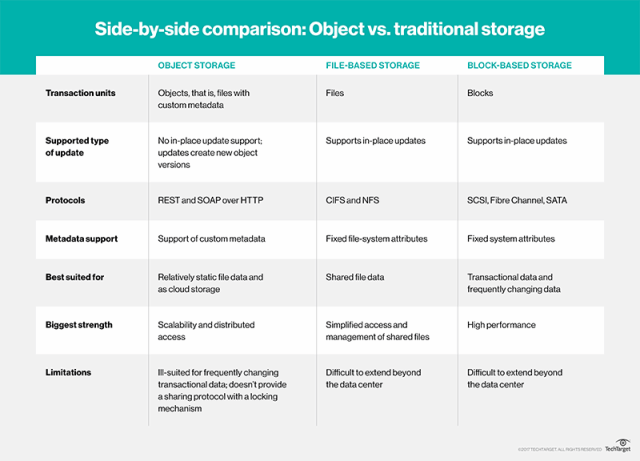Cloud object storage stores unstructured data(like application images or media files) in the cloud. Object storage is elastic, flexible and easily scalable into multiple petabytes which ideal for environment where data growth is unlimited hence it is considered a good fit for the cloud.
Contrary to Block Storage which deal data as block and logical volumes, file storage which is a hierarchical files structure storage; Object Storage Architecture stores and manages data as objects. Block and file storage prove expensive and difficult to scale to meet day by day massive amounts of data growth storage requirement.
The metadata have association with Objects which are stored in Cloud Storage. The Metadata task is to indicate and explain the properties of the object and the object handling during its accessed. Metadata exists as key:value pairs. For example, for the object storage class it represented by the metadata entry storageClass:REGIONAL. Where storageClass is the key for the metadata, and all objects have such a key associated with them. REGIONAL specifies the value this specific object has, and the value varies from object to object.
To support larger namespaces and eliminate the name collisions Object storage adds a unique identifier within a bucket, or across the entire system. Object storage remove burden of Administrators for performing lower-level storage functions such as creating and administering the logical volumes to utilize disk capacity or setting RAID levels for coping up with disk failure.
An Object Identifier is mapped with object, it is address through which object can be found over a distributed system. Objects may be spread across multiple data centers located in different parts of the world. The object storage based data can be available easily without user need to know about the specific physical data location
Object Storage remove the need of Operating System support like it require for block storage volumes, which can only be accessed through operating system when they are mapped. APIs (Application Programming Interfaces), HTTP and HTTPS are only method to access the Object storage, along with the metadata.

Figure 1: An example of Cloud object storage real world application. Source: FNTS
Benefits of cloud object storage include:
- Eliminates storage silos (fully distributed, scales horizontally)
- Built in disaster recovery
- Built for long-term data retention
Features of cloud storage include:
- Scalable: worry-free scalability with unlimited apps, users and files
- Accessible: active-active architecture, multi-site, single global namespace enables anywhere access to content from any application or device
- Flexibility: multiple front end appliances, software and storage arrays exist today that interface seamlessly and utilize cloud object based storage for another cold data tier
- Secure: multi-tenancy allows for total isolation of data stored is encrypted on the cloud object storage array via D@RE (Data at Rest Encryption). Options for client side encryption methods allow for objects to be encrypted when written to cloud object storage

Figure 2: Comparison Table of Object Vs. Tradition Storage Source: TechTarget
History:
After introduction of cloud object storage service AWS S3 in 2006 Amazon Web Services has started revolution in Storage industries, AWS S3 has gained widespread recognition and it has been adopted as the storage supplier for many popular services such as Smugmug, Dropbox, Synaptop and Pinterest. In 2005, Box also announced an online file sharing and personal cloud content management service for businesses which is also adopted by many companies.
But few of us know that the foundation of Cloud storage led by ARPANET for connecting people and data from anywhere at any time. It was invented by Joseph Carl Robnett Licklider in the 1960s while working with ARPANET.
After many companies like CompuServe (In 1983) and AT&T (In 1994) had started giving space through Web or FTP based for sharing and uploading any files to their consumers.
There was famous commercial of AT&T in 1994, when it launched PersonaLink Services, an online platform for personal and business communication and entrepreneurship. The storage was one of the first to be all web-based, which they refer in their commercials as, “you can think of our electronic meeting place as the cloud.”
Click on the below reference commercial video clip to watch:
Cloud Object Storage Vendors:
Now days many vendors are providing Cloud Object Storage some of them are as below:
Amazon Simple Storage Service (S3), Caringo Swarm, Cloudian HyperStore, Dell EMC Elastic Cloud Storage, Hewlett Packard Enterprise Scalable Object Storage based on the Scality Ring software-defined storage platform, Hitachi Vantara’s Hitachi Content Platform, IBM Cloud Object Storage and the OpenStack Swift open source object storage system.
Reference Sources:
https://en.wikipedia.org/wiki/Cloud_storage
https://searchstorage.techtarget.com/definition/cloud-object-storage
https://searchstorage.techtarget.com/definition/object-storage
https://cloud.google.com/storage/docs/metadata
https://www.fnts.com/cloud/view/cloud_object_storage

It seems to be like ocean,in which many kinds of streams flow,hot,cold,salty,yet is grabbing new inputs.